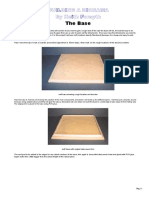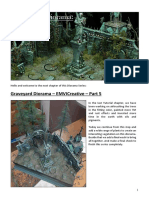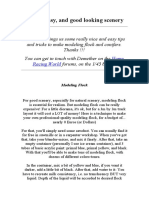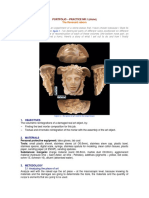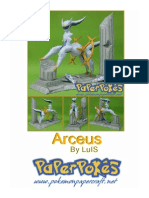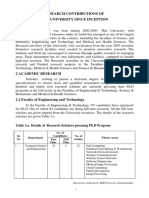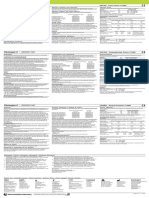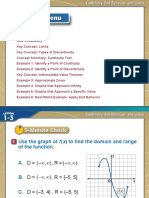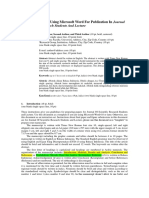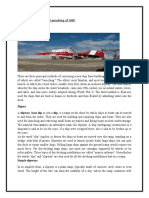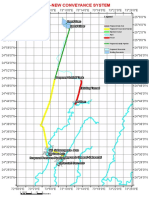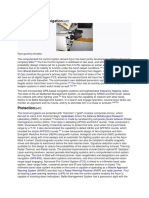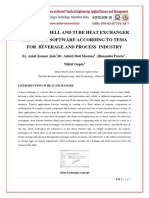Creating a stone base for display models
Hello and welcome to my first tutorial.
I decided to start with building a stone base with earth. With this method I create the most of my bases.
The results can even be more interesting and unique when adding other elements for example old
statues, a wall, a house, Si-Fi elements, water effects...many possibilities. But for this tutorial I wanted to
focus on the basic techniques, for a better understanding and following on all steps. What do we need?
Materials:
-A wood socle
-Pine tree bark
-Milliput Standard Yellow-Grey
-Fine earth
-Sawdust (optional)
1
�Tools:
-Superglue
-A sculpting Tool
-Old brushes
-A little wood block
-Double sided glue tape
-Sanding papers (rough & fine)
-A cork block (optional)
-Cutter
-Scissors
-Tweezer
As on the most of my dioramas I use tree bark for the main elements. I like this material because it is
cheap, you can cut and break it easy and sand it with sand paper to get smooth sides. The best is, it has
a very interesting texture, which creates a very natural look and the rough surface makes painting lot
easier and washes can help to get a very realistic result. I use two types of bark one is cork and on this
tutorial I used pine tree bark. Please don’t cut the bark of trees, only take them of the ground. If you
can’t find them, I sell them for a fair price, just to give you the option.
I would recommend to not mix different stone types on the base, because you want to represent only
one kind of stone. Like in real, in one area the stones have the same structure. Sure it is always possible
to add some smaller stones. But the main stones on the base, should look more or less equal from the
structure.
2
�Preparation:
I start the most projects, with choosing a nice model I want to paint. This time I decided to use one of
the new Rising Sun Boardgame miniatures. Afterwards I think about the base and pick the right size for
the wood socket. I have many of them at my home so I can choose and test different by holding the
figure on it. Like in the most parts of the hobby, there is not just one right solution. I recommend to
choose a base that gives enough opportunities for built up a nice scene, but on the other side it
shouldn’t be too big. We don’t want that the figure gets lost in the base.
1: Size may fit, but for harmonic miniatures I prefer round bases
2: A little specific and too small.
3: By far too big, may work for a larger diorama with big elements around the figure or more figures.
4: Worked best for me. I take this one.
Tip: Start with building the base, after that paint the model. In this case you can always pick up the
model and test positions without damaging any painted areas. And you have the guaranty that the
figure fits perfect to the base in the end.
Building up Base volumes, working with bark pieces:
For this one, I decided to go with the pine bark. I think it fits better than cork bark on smaller projects. I
took a big piece and broke it in smaller pieces. The good thing is, they break with irregular forms, which
all can be used. Than pick the socket and try to test different pieces. I always try to have the figure on an
uphill position. And have bigger elements in the back. More about good placement of elements in a
separate tutorial.
So now let us start the work. The base consists of many single bark pieces. I work with Milliput Standard
yellow-grey to connect them. This is not that expansive, good to work with it and you can sand it when it
is hard after 24 hours. You can work about 2 hours on it, than it’s already harder, but for basing that is
enough time. On dioramas you can work on separate areas step by step. Break the bark in pieces and
then test positions. Test if the miniature fits to it and how much the figure should be above the wood
socle.
3
�When you like a position of one piece add a bit of Milliput under it, than it stays in position and you can
continue find next piece. When you are complete sure add superglue between the Milliput and the bark.
But even with superglue you can slightly change positions when pressing in one direction until the
Milliput is hard. For those who don’t know Milliput is a two components putty. Which hardens out after
you mixed it.
Tip: When you work with Milliput, try to wash the hands after you mixed the 2 components, because we
don’t want to destroy details of the figures with Milliput.
Basing is bit like painting, you start with the base volumes and forms, after that you work on the details
and make everything smooth. I found a nice bark piece which was the stone where the figure stands on.
Around that I added few more little pieces.
On the next pictures you can see how I started building up the volumes. At first I tested a position but
didn’t like the piece and switched to another. Then I added a second, same thick piece over it. But the
base became too high and I changed the second piece to a smaller bark piece.
4
�Over the complete project you have to be flexible, not all ideas come in the first minutes. The most
times, when I start bases like that, I don’t have an exact idea in mind. I let me inspire by the pieces and
then built it up piece by piece. Keep your model near and test positions.
Tip: For a good balance the miniature should be in the center of the base.
Then I used my hands and a sculpting tool to push more Milliput in the holes and fill the gaps. And to
gives it more stability. With a sharp tool you can start sculpt forms of the bark pieces in the putty. In this
case irregular horizontal lines.
Let the Milliput overlap over all sides. When everything is complete dry we sand it and it is perfectly
straight. You can see the ideal line in the right picture as blue line. The red marked area will be removed
after it is hard with sanding paper.
I also used Milliput to add some structure on the front of the base that you don’t see the straight edge
of the wood base. I think this is pretty important step, because the base will look much more realistic
when you can’t see where the transition between the wood socle and your putty is. It is boring, when
the base side is just plain. Makes sense for a street base, but not for such a rocky landscape. Try to
create an irregular form like the blue one that is sketched in the next picture.
5
�Creating the earth
I wanted to have a stone base, but also with earth elements between it. The earth should be on flat
areas and in gaps. Areas that wouldn’t be flushed by heavy rain. On the edges of the stone pieces there
is no earth. This is very easy to simulate, you add little Milliput pieces to the areas you want to have as
earth. With the tool you press it on the base and already sculpt rough forms on the earth (no structure,
just basic volumes). On the back of the base we need a little more Milliput, you can take a little wood
piece to press it in the cylindrical base form. As on the front let it overlaps a bit, we will clean it with
sanding paper later.
Tip: When working with Milliput, keep your tools wet, makes it easier.
Adding texture with old brushes
And than we want to add more texture to the earth. You can use a very old brush for that. You make
them wet and than dip or rub over the surface with the old rough brush. With old I mean the brush can
be much destroyed. When you have too less water, take more water, when you have too much you can
take a hairdryer to let is dry again. Just test it, you will see it is very easy. When you like the texture,
you’re ready for the next step. More destroyed brushes lead to more rough landscape. But it also
depends how hard to push into the putty. Test it, you can’t make anything wrong here.
6
�Now we want to add the fine earth texture. We start with wet the Milliput, that should represent earth
with the same old brush from before (left picture, above) and water. Not too much just a bit. The stone
areas should be dry. We don’t want that the earth fits there. Than take fine earth in the hand and let it
rain over the base with your fingers. Press a little with your tool on it, really just a little.
And then turn the base over the earth box and clap on it, that the lose earth falls in the box again. Than
it should look somehow like this one (lose earth is still on the base on this picture).
7
�Now you can make the same with fine earth, for that I use sawdust. And make same like before, let it
“rain” over the areas you want to have the fine earth (no need to wet the Milliput second time). Than
clap on the base bottom after it again to remove it from lose sawdust. When you have it on areas you
don’t want, take a brush make it bit wet and rub very softly for the area. I did that for example on some
of the stones structures. As I wrote above I don’t want to have the earth on the base sides.
Tip: Push the figure on the base now, just a little bit, that you can see if he stands flat. If not correct it
with adding little bit of putty. Nothing worse than a finished figure that isn’t properly glued on a base
and has a huge gap under the feet or a figure that stands aslope.
Now you can also add some smaller bark pieces to the base with gluing them on the base or just press
them in the Milliput to get the stones structure in the putty. But that is the final step. Now let it dry for a
day. The base doesn’t look that special at this time, but you will see it will improve in every step.
8
�Sanding the base and finish the sculpting
When the Milliput is hard you can sand the edges by using sanding paper. I glue it with double sided
gluing paper on a piece of cork. I prefer that, because than you create a very straight sides on the base.
Start with a rough sanding paper and when the main form nearly fits you can use fine sanding paper. Try
that the Milliput and overlapping bark is sanded straight to the edges of the base. That you have a
smooth transition from socle to sculpted base. Later, when the base is painted, you won’t see where the
wood ends and the base starts. This makes your display models appear much better. It’s good when
people who watch it, see that you not only work smooth on the figure, also on the base and wood socle.
Tip: On areas, where the bark is very thin or something breaks, add superglue (very thin fluid). This one,
won’t change or cover up any textures of the base.
9
�Finished sanding
You can see the straight line on the base side now. With the sanding it looks much better than before.
On the front in the red circle, I made an exception, this rock was in the air, and I decided to let him
overlap the cylindrical base. Reason is, this is directly in the front view. When I have the front view and
sand it and paint it black later it just looks not good and will steal the focus from the miniature. I made a
little picture that you see what I mean. The second picture.
10
�Adding roots and a bush:
After sanding I added some little roots and little plants that are growing up the stones. Using real roots
and materials I found outside. I used superglue, and a tweezer to add them and a little tooth pick to
push them in the right form. I did this after sanding, because I didn’t want to destroy small, filigree
details with my hands when I do the sanding work.
Beside that I added a little bigger root on the top of the base to represent a little bush later.
11
�Tip: When adding bushes, trees and other big elements, try to set them beside or more often behind the
figure, not in the front. The most times we want to have a good look on the figure, because the painted
model is the main element. And as on the other basing steps, try to check the position of the bush with
the miniature. The placement of bigger elements, like bushes, trees, bigger stones, or other materials, is
very important for a good balance of the base.
Now some proper pictures of the sculpted base, ready for get painted.
And complete with the miniature:
12
�The first Tutorials ends here, but I wanted to show you a picture of the finished base. That you know
where this work can lead to. Some elements may appear complicated, but you will see it isn’t and with
some training you can achieve cool results in fast time. Especially compared to painting time. I think it
took me about 2,5-3,5 hours to finish this sculpting step.
This is my first that detailed Tutorial. If you have questions or ideas for improvement please let me
know. I hope it’s useful for you! :)
Best regards
Oliver
©Copyright 2018 Oliver Spaeth. All Rights Reserved.
13















